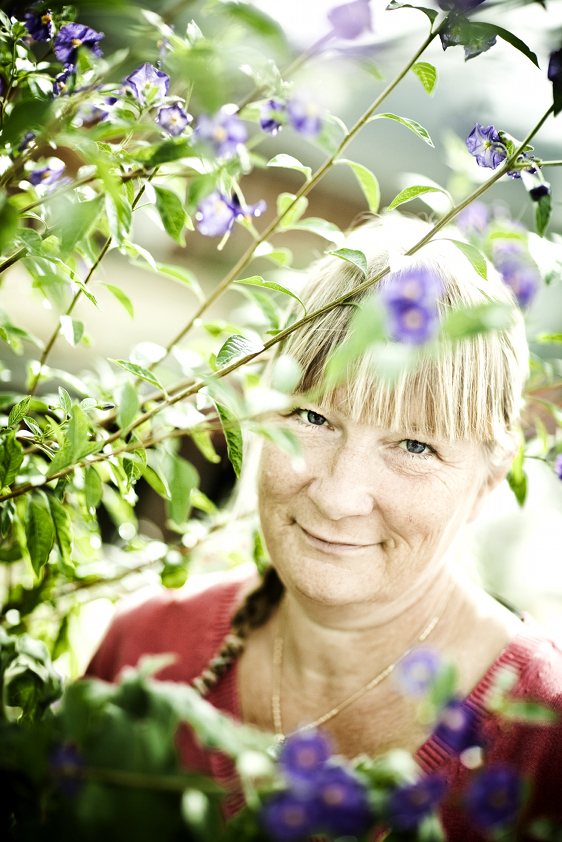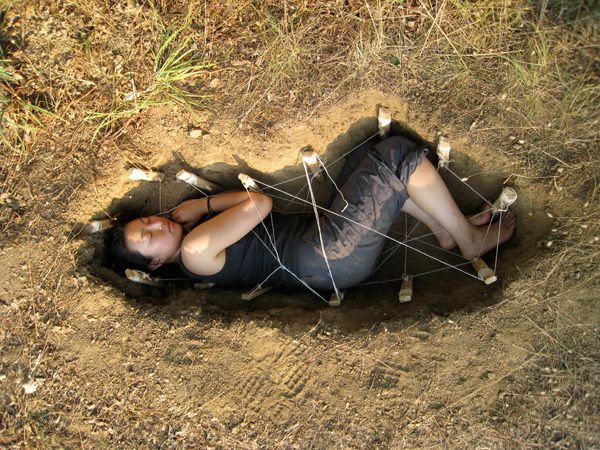Burial and cremation of the deceased are rituals that began centuries ago and are by far the two most popular methods of corpse disposal in modern times. However, with rising concern about the negative effects these post-mortem traditions have on our planet, people are beginning to invent new, creative and environmentally-friendly ways to lay our dead to rest. Some of the new techniques explained below may seem a tad creepy, or even disrespectful to the deceased, but before you dismiss these new methods as an option for yourself or a loved one, take a moment to consider what the body goes through during burial and cremation along with what effects these practices have on our environment.
In modern burials, the body is usually embalmed, which involves all the blood being removed from the body and replaced with formaldehyde and various chemicals to preserve the corpse. All orifices including the eyes, mouth and nose are cleaned with a powerful disinfectant. Sometimes, the mouth is sewn shut, and usually, cotton balls or plastic lenses are places under the eye lids to prevent them from sinking back into the sockets in a way that would appear unnatural. The anus and vagina are generally packed with cotton as well to avoid any leakage. Hopefully, no one would allow someone to inject their grandmother with carcinogens and stuff cotton balls in her anus and vagina while she was alive, so why is it considered normal in our society to pay someone to do that to her body in death? The casket is then buried so deep underground that the body inside is not exposed to enough oxygen to allow the natural decomposition to take place. Instead of introducing the remains back into the earth as mulch, they simply rot, and along with the dead, each year in the United States alone we bury 800,000 gallons of formaldehyde-based embalming fluid. According to a study by the Center for Disease Control, there are 219 chemicals found in the average human body and despite efforts to contain these chemicals, along with those used for embalming, they will inevitably leak out into the surrounding soil. This can contribute to oxygen depletion of our seas and eutrophication. Many people see cremation as a less harmful method, but unfortunately these same 219 chemicals found in the body remain after cremation and can cause just as much damage when scattered or buried. Eventually, the possibly toxic, fragmented remains will make their way to our water sources. Each cremation, which lasts approximately 45-90 minutes, requires more than five gallons of fuel, and during the process mercury, carbon dioxide, carbon monoxide, and countless carcinogens are released into our atmosphere. Even if the environmental impact of cremation doesn’t bother you, imagine your body burning at 1,400-1,800 degrees Fahrenheit for close to, or over an hour, before having your bones ground to pieces in a mill. Of course, you won’t be alive to feel it happening, but since that is the case, why not choose a more environmentally-friendly method?
Invented by biologist Susanne Wiigh-Masak, “Promessa” is rising in popularity as an alternative to cremation in Sweden. First, the corpse is frozen to just below zero degrees F, the corpse, contained within the coffin, is then lowered into a vat of liquid nitrogen. This freeze drying process causes the remains to become so brittle, they will crumble into a fine powder when subjected to a vibration of a specific amplitude which lasts less than sixty seconds. This allows the water which makes up about 70% of the average sized human body to separate from the remains and be vacuumed out, converted into a sterile steam. Bits of mercury from dental fillings along with any surgical metals from the body are filtered from the dry remains using a magnetic field. The entire process takes about two hours to complete. Your loved ones may then take you home in your new, odorless, organic powder form or you may choose to have your remains buried in a starch urn which will, along with the remains, become mulch in six months to one year.
The rapid decomposition is due in part to the shallow burial offered with Promessa which allows the remains the necessary exposure to oxygen. The Promessa website assures the process “does not subject the body to violent or destructive handling”, but if you’re still a bit discomforted at the thought of your bones being reduced to dust so quickly after your demise, perhaps you’d prefer being liquefied.
Always wanted your remains to be dissolved in a barrel of lye without all the hassle of being brutally murdered by a deranged serial killer? Well, with Alkaline Hydrolysis all your dreams (or nightmares) can finally become a reality! Originally developed for the disposal of animal carcasses, Alkaline Hydrolysis, or “Resomation” is currently available for humans in several states and many more are working towards legalizing the process. The body is placed in a “resomator”, which is basically a human-sized pressure cooker.  The resomator produces sixty pounds of pressure per square inch and is filled with a mixture of water and potassium hydroxide which is heated to about 350 degrees F. After two to three hours, the body is reduced to a pile of bone fragments, similar to those seen in cremation, and a sludgy, brown liquid that smells strongly of ammonia is left behind. Yes, that liquid is liquefied human remains. It is separated from the bone fragments and any pieces of surgical metal that remain are filtered out. While you are free to take the solid remains home in an urn as with cremation and promessa, the sterilized, DNA-free liquefied remains of your loved one will, in most cases, be poured down the drain (given the proper permits of course) and “returned to the water cycle” as their website so disturbingly states.
The resomator produces sixty pounds of pressure per square inch and is filled with a mixture of water and potassium hydroxide which is heated to about 350 degrees F. After two to three hours, the body is reduced to a pile of bone fragments, similar to those seen in cremation, and a sludgy, brown liquid that smells strongly of ammonia is left behind. Yes, that liquid is liquefied human remains. It is separated from the bone fragments and any pieces of surgical metal that remain are filtered out. While you are free to take the solid remains home in an urn as with cremation and promessa, the sterilized, DNA-free liquefied remains of your loved one will, in most cases, be poured down the drain (given the proper permits of course) and “returned to the water cycle” as their website so disturbingly states.

When we die, our bodies become water, and others drink the water. And so we are all connected in the great Circle of Life…
The thought of pouring Granny down the drain may seem to lack reverence, but keep in mind that even after death, your loved one will always be with you… perhaps literally if you don’t have a water filter. This is indeed, wonderful news for cannibals considering going on a liquid diet.
Speaking of cannibals, if you’re familiar with NBC’s Hannibal series, you may experience deja vu in a few moments.  Have you ever thought to yourself, “Maybe I can train an army of toxin-cleaning, edible mushrooms to eat my body…”? If you have, you are probably Jae Rhim Lee, artist and creator of The Infinity Burial Project. She has been wearing a “mushroom death suit” embedded with mushroom spores, and covered in a crocheted pattern which is meant to act as mycelium, or mushroom “roots”.
Have you ever thought to yourself, “Maybe I can train an army of toxin-cleaning, edible mushrooms to eat my body…”? If you have, you are probably Jae Rhim Lee, artist and creator of The Infinity Burial Project. She has been wearing a “mushroom death suit” embedded with mushroom spores, and covered in a crocheted pattern which is meant to act as mycelium, or mushroom “roots”.  Like something straight out of a horror film, Jae has been training these mushrooms to eat her dead skin cells, sweat, urine, feces, and tears in hopes that when she dies, they will recognize her body… and eat it. She refers to these flesh-eating mushrooms as “Infinity Mushrooms”, but really the suit is made of your everyday shiitake and oyster mushrooms. Testing will begin with expired meats, then move on to humans, and there are already a few volunteers for the project. Jae is very accepting of death and is straightforward, yet lighthearted when she speaks on the subject. She’s even begun a ‘Decompiculture Society’ dedicated to encouraging others to accept their own impending demise and plan for it in a practical and eco-friendly manner.
Like something straight out of a horror film, Jae has been training these mushrooms to eat her dead skin cells, sweat, urine, feces, and tears in hopes that when she dies, they will recognize her body… and eat it. She refers to these flesh-eating mushrooms as “Infinity Mushrooms”, but really the suit is made of your everyday shiitake and oyster mushrooms. Testing will begin with expired meats, then move on to humans, and there are already a few volunteers for the project. Jae is very accepting of death and is straightforward, yet lighthearted when she speaks on the subject. She’s even begun a ‘Decompiculture Society’ dedicated to encouraging others to accept their own impending demise and plan for it in a practical and eco-friendly manner.
If Jae’s vision isn’t artistic enough for you, you could donate your body to Body Worlds, the infamous cadaver art exhibit.
Body Worlds uses “plastination”, a technique invented by Gunther von Hagens in 1977 for medical students to better observe the human anatomy. Today, it is considered not only a valuable teaching tool, but an art form and a unique alternative to burial or cremation. The dissection and plastination of one full body usually takes about a year to complete and 1,500 hours of work. To begin, formalin is pumped through the arteries which kills bacteria in the body and prevents its decay. All skin, connective and fatty tissues are removed, and the body is submerged in an acetone bath to dissolve soluble fats and bodily fluids. It is then placed in a vacuum chamber which removes the acetone from the body and replaces it with liquid polymer.  The polymer used during the process varies based on several factors and will effect the overall look of “the piece”. The body is placed in the desired position and often supported through the use of wires, clamps, needles, and foam blocks.
The polymer used during the process varies based on several factors and will effect the overall look of “the piece”. The body is placed in the desired position and often supported through the use of wires, clamps, needles, and foam blocks.  Then, the polymer is hardened using heat, light, or gas depended on the polymer used for that individual corpse. Although you may end up in pieces once plastinated, your body must be “largely intact” to be accepted as a donor, so plastisination is not usually an option for someone who died in a violent manner.
Then, the polymer is hardened using heat, light, or gas depended on the polymer used for that individual corpse. Although you may end up in pieces once plastinated, your body must be “largely intact” to be accepted as a donor, so plastisination is not usually an option for someone who died in a violent manner.  Donating your body to Body Worlds does not guarantee your body will be on exhibit, as many are sold to medical schools and various training programs.
Donating your body to Body Worlds does not guarantee your body will be on exhibit, as many are sold to medical schools and various training programs.
While all these methods are currently believed to have less of an impact on the environment than burial or cremation, there are skeptics. Many believe the resources used in some of these more modern techniques are just as detrimental to the health of our planet as the tried and true practices of burial and cremation. If you already have your heart set on a specific post-mortem option but would like to offset its environmental impact, you can visit http://www.carbonfund.org and make a donation, or consider a biodegradable urn or casket. As morbid as it may seem, it is important to make your post-mortem plans and make them known to others sooner rather than later. We all like to believe we’ll live to a ripe old age and don’t need to plan for our funerals until we reach our senior years, but in reality, the Grim Reaper can come for us at any time. In the end, you should choose to do with your body after death whatever makes you most comfortable, but keep in mind long after you are dead and buried (or plastinated, or liquefied, or consumed by an army of flesh-eating mushrooms) billions of people must continue living in a world with the carbon footprint you left behind.
If you enjoyed this article, please donate $1 to The Post-Mortem Post so we can make massive improvements to the site; If everyone who reads this article today donates just $1, we will surpass out goal.
Follow us on Twitter @PostMortem_post and Like The Post-Mortem Post on Facebook
To learn more about these options visit:
Promessa:
http://www.promessa.se/en/
Alkaline Hydrolysis/Resomation:
http://www.resomation.com
Infinity (Mushrooms) Burial Project:
http://www.infinityburialproject.com
Plastination:
http://www.bodyworlds.com

